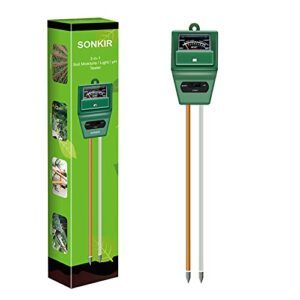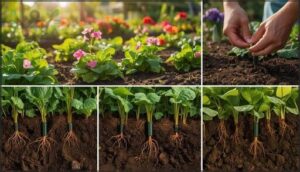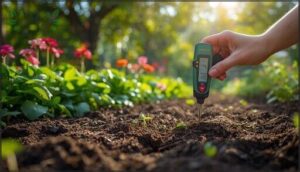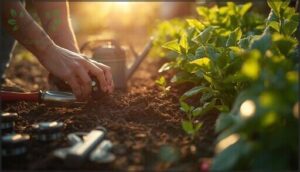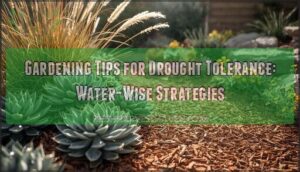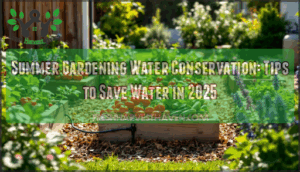This site is supported by our readers. We may earn a commission, at no cost to you, if you purchase through links.
Summer heat pushes gardens to their limits, turning soil moisture management from a weekly chore into a daily guessing game. You might water religiously each morning, only to watch tomatoes crack from overwatering or peppers wilt despite what looks like damp soil.
The problem isn’t your dedication—it’s that eyeballing moisture levels doesn’t account for varying soil depths, microclimates within your beds, or how quickly different plants drain available water.
Soil moisture monitoring removes this uncertainty by measuring exactly what’s happening in the root zone where it matters most. The right meter paired with proper placement techniques transforms irrigation from reactive crisis management into a data-driven approach that keeps plants thriving through heat waves while conserving water and preventing nutrient leaching.
Table Of Contents
- Key Takeaways
- Why Soil Moisture Monitoring Matters in Summer Gardens
- Choosing The Right Soil Moisture Sensor
- Top 10 Soil Moisture Meters for Summer Gardens
- 1. XLUX Soil Moisture Meter Monitor Sensor
- 2. Gouevn Soil Moisture Meter for Plants
- 3. XLUX Long Probe Soil Moisture Meter
- 4. Reotemp Fifteen Inch Soil Moisture Meter
- 5. Ecowitt Wireless Soil Moisture Tester Sensor
- 6. Kensizer Soil Tester Moisture pH Meter
- 7. Gain Express Soil PH Meter
- 8. 4-in-1 Soil Tester Meter
- 9. VIVOSUN 3-in-1 Soil Tester
- 10. Sonkir 3-in-1 Soil Tester
- Best Practices for Sensor Placement and Use
- Interpreting Soil Moisture Readings and Metrics
- Maintaining Sensors and Optimizing Garden Irrigation
- Frequently Asked Questions (FAQs)
- Conclusion
Key Takeaways
- Soil moisture sensors eliminate guesswork in summer irrigation by measuring real root zone conditions, preventing both overwatering that causes root rot and underwatering that blocks nutrient uptake—keeping moisture between 75% and 95% of field capacity optimizes plant health while suppressing disease.
- Choose sensors based on your garden’s scale and soil type: analog meters work for simple spot-checks in small plots, while wireless options monitor multiple beds remotely, but clay soils may need calibration adjustments and probe length must reach 6-12 inches to access active root zones.
- Proper sensor placement at the correct depth (typically 6-12 inches) with horizontal orientation and firm soil contact delivers accurate readings, while common errors like installing outside root zones or leaving air gaps around probes can skew data by over 10%.
- Regular calibration (once or twice yearly) and maintenance—cleaning probes weekly, checking for damage, and adjusting trigger points based on soil type—transforms sensor data into precise watering schedules that can reduce water use by up to 70% while improving plant yields.
Why Soil Moisture Monitoring Matters in Summer Gardens
Summer heat puts serious pressure on your garden, and guessing when to water can mean the difference between thriving plants and wilted disappointment. Soil moisture monitoring takes the guesswork out of irrigation decisions, giving you reliable data that protects your investment of time and effort.
Understanding why these tools matter will help you choose the right approach for your specific garden conditions.
Impact on Plant Health and Growth
When soil moisture dips too low, your plants struggle to absorb nutrients like phosphorus and potassium, stunting root development and weakening overall plant health. Conversely, waterlogged root zones create oxygen-starved conditions that invite root rot and other diseases.
Proper soil moisture monitoring helps you maintain the sweet spot where roots thrive, nutrient uptake remains efficient, and soil structure fosters strong growth optimization throughout the demanding summer months. Understanding nutrient uptake mechanisms is key for effective fertilisation.
Preventing Overwatering and Underwatering
The right balance keeps your garden productive, but overwatering drowns roots while underwatering halts growth. Soil moisture monitoring removes the guesswork from watering practices, giving you clear data before each irrigation cycle.
Key indicators to watch include:
- Root zone moisture readings that prevent soggy or bone-dry conditions
- Mulch moisture retention extending watering intervals by 2-3 days
- Visual plant cues like wilting or yellowing that confirm sensor alerts
- Soil drainage impact on how quickly moisture depletes after irrigation
Watering schedule adjustments based on sensor data help you apply water only when needed, avoiding the extremes that stress summer vegetables and ornamentals. Recognizing the signs of plants not thriving is essential for maintaining a healthy garden. Smart watering techniques for plants mean healthier roots and fewer disease issues.
Role in Nutrient Uptake and Disease Prevention
Moisture does more than hydrate your plants—it unlocks nutrient solubility, enabling ion exchange that delivers minerals to hungry roots.
When you maintain moisture between 75% and 95% of field capacity, you boost microbial activity that cycles nitrogen and phosphorus while suppressing root rot and fungal diseases.
This sweet spot optimizes uptake dynamics, improving plant health without the waterlogged conditions pathogens love.
Choosing The Right Soil Moisture Sensor
Before you invest in a soil moisture sensor, you need to understand what’s available and how each type fits your garden’s specific needs. The right meter depends on your budget, the level of detail you want, and whether you prefer hands-on monitoring or automated alerts.
Let’s walk through the main sensor categories and features that matter most for keeping your summer garden thriving.
Analog Vs. Digital Meters
When choosing soil moisture meters, you’ll face a fundamental decision between analog and digital technology. Analog meters cost just a few dollars and require no batteries, but their accuracy suffers in high-salt soils due to altered conductivity.
Digital meters, ranging from tens to hundreds of dollars, deliver precision within 0.1% moisture content through dielectric measurement.
This technology difference directly impacts your watering decisions and long-term garden success.
Smart and Wireless Monitoring Options
When irrigation feels like guesswork, smart sensors transform your approach. Wireless connectivity via Bluetooth, WiFi, or Zigbee links soil moisture sensors directly to your smartphone app, enabling remote monitoring from up to 300 feet away.
Battery life generally extends five to eight years, while data accuracy holds within ±2 to ±5 percent volumetric water content. Sensor calibration adjusts readings to match your specific soil conditions for reliable wireless range performance.
Key Features for Summer Gardens
Summer heat demands sensors built to last. Weather resistance ratings like IP67 guarantee protection from dust and water immersion, while UV-resistant housings prevent sun damage over multiple seasons. Measurement accuracy of ±1 to ±3 percent volumetric content ensures your watering decisions reflect real conditions.
Focus on these critical features:
- Durability: Capacitive or TDR sensors last five to ten years versus one year for resistive models
- Display features: Sunlight-readable LCD screens reduce misinterpretation by 40 percent
- Best measurement depth: Probes reaching six to twelve inches access active root zones for accurate soil moisture monitoring
Matching Sensors to Soil Type and Garden Size
How do you pick a sensor that actually works in your soil? Soil texture impacts accuracy—clay can trigger false high readings, while sandy soils need calibration for low retention. Sensor probe length must reach root zones: six to twelve inches for most vegetables.
Garden size influences your choice too. Small plots suit compact analog meters, whereas larger spaces benefit from wireless sensor range up to three hundred feet.
Deployment best practices include matching sensor placement to predominant soil conditions.
Top 10 Soil Moisture Meters for Summer Gardens
Once you’ve identified the features that matter most for your summer garden, the next step is selecting a meter that fits your needs and budget.
The following ten options represent proven tools used by both home gardeners and agricultural professionals. Each offers different capabilities, from basic analog readings to sophisticated wireless monitoring systems.
1. XLUX Soil Moisture Meter Monitor Sensor
The XLUX Soil Moisture Meter offers a straightforward solution for gardeners seeking reliable moisture readings without the hassle of batteries. Its large analog dial displays ten scales across three color zones, making interpretation quick even in outdoor conditions. You simply insert the single probe into your soil and get instant feedback.
User feedback consistently highlights its accuracy across different soil types, from sandy beds to clay-heavy plots. The no-battery design encourages sustainable practices while the affordable price point makes it accessible for monitoring multiple plants throughout your summer garden.
Best For: Home gardeners and plant enthusiasts who want a simple, reliable way to check soil moisture levels without dealing with batteries or complicated digital displays.
- Instant readings with no batteries required—just insert the probe and read the color-coded dial
- Single probe design minimizes root damage when testing multiple plants throughout your garden
- Affordable and eco-friendly with no electronic waste or ongoing maintenance costs
- Doesn’t work well in very hard, rocky, or compacted soil conditions
- Only measures moisture—no pH or nutrient readings included
- Probe can corrode if left in soil too long, requiring careful cleaning and quick removal after testing
2. Gouevn Soil Moisture Meter for Plants
The Gouevn Soil Moisture Meter stands out with its 7.7-inch metallic probe, reaching deeper into root zones than many competitors. Meter accuracy proves reliable in typical garden conditions, though probe durability requires care—avoid forcing it into rocky or extremely compacted soil.
You’ll appreciate the included watering guide covering over 200 plant species, which transforms raw readings into actionable decisions. User experience remains straightforward with its battery-free analog design and color-coded moisture zones.
Soil moisture sensors like this work best when you insert them 3 to 5 inches deep and clean the probe after each use.
Best For: Home gardeners and plant enthusiasts who need a simple, reliable way to check soil moisture without dealing with batteries or complicated setup.
- Long 7.7-inch probe reaches deep into root zones for accurate moisture readings, plus it works without batteries using soil conductivity
- Comes with a helpful watering guide covering over 200 plants, making it easy to know exactly when to water
- Color-coded dial gives instant, easy-to-read results that even beginners can understand at a glance
- Probe can bend or break if you push it into very hard, rocky, or compacted soil
- Some users report inconsistent readings or false dry signals, especially in certain soil types like orchid mix
- Only measures moisture—no pH or light readings—and shouldn’t be left in soil long-term to avoid corrosion
3. XLUX Long Probe Soil Moisture Meter
When you need to monitor soil moisture in containers taller than ten inches, the XLUX Long Probe Soil Moisture Meter delivers with its 10.23-inch probe depth. Analog accuracy remains consistent, and user feedback confirms reliable readings in deep root zones without battery complications. The battery-free design eliminates power concerns entirely.
Practical usage tips include gentle insertion to avoid bending the thin probe and prompt removal after soil moisture meter testing. Clean the probe after each use to prevent corrosion and maintain the precision you’ll rely on during summer’s demanding conditions.
Best For: Gardeners with large or deep pots who need to check moisture levels beyond the surface without the hassle of batteries.
- 10.23-inch probe reaches deep root zones that standard meters miss, perfect for tall containers and garden beds
- No batteries needed means it’s always ready to use and won’t die on you mid-season
- Color-coded dial makes readings instant and foolproof, even for beginners
- Thin probe can bend if you force it into hard or rocky soil
- Needs to be wiped clean after every use to prevent corrosion and keep readings accurate
- Can’t be left in the soil long-term, so it’s not ideal if you want continuous monitoring
4. Reotemp Fifteen Inch Soil Moisture Meter
For compost piles and deep-rooted perennials, the Reotemp Fifteen Inch Soil Moisture Meter reaches zones other analog readings can’t touch. Its rugged stainless steel construction withstands heavy garden use, and the 15-inch probe length lets you assess moisture at depths that matter for established plantings.
Meter calibration is user-adjustable on a 0-10 scale, though soil conductivity variations may require occasional recalibration. Battery access involves removing screws, which is less convenient than other designs. Still, this Reotemp garden and compost moisture meter tackles demanding soil moisture monitoring tasks reliably.
Best For: Gardeners and composters who need to check moisture levels deep in compost piles or around established plants with long root systems.
- 15-inch probe reaches deeper than most analog meters, perfect for thick compost piles and mature plants
- Sturdy stainless steel build holds up well in tough soil conditions and heavy use
- User-calibratable scale lets you dial in the exact moisture target for different plants or compost setups
- Calibration takes some trial and error, especially if you’re working with different soil types
- Battery compartment requires unscrewing, which is a hassle when you need to swap batteries
- Readings can shift based on soil salt content, so you might need to recalibrate more often than you’d like
5. Ecowitt Wireless Soil Moisture Tester Sensor
If you’re managing multiple beds or want to check moisture readings without walking through wet soil, the Ecowitt Soil Moisture Tester delivers remote monitoring through wireless connectivity. Its one-meter probe reaches down where roots actually drink, transmitting data every 70 seconds to your smartphone via a Wi-Fi gateway.
Battery performance extends beyond 12 months, and calibration accuracy improves when you adjust settings for your specific soil type.
Data interpretation becomes straightforward as trends reveal when your soil moisture levels drop below trigger points for irrigation.
Best For: Gardeners managing multiple planting areas who want to monitor soil moisture remotely without trudging through their beds every day.
- Sends real-time moisture data to your phone every 70 seconds, so you can check conditions from anywhere without getting your boots muddy.
- The one-meter probe gets down to root level where moisture actually matters, not just surface readings that miss what’s happening deeper.
- Battery lasts over a year on a single AA, and some users report getting 3 years of use even through harsh winters.
- You’ll need to buy a separate Wi-Fi gateway to access the wireless features, which adds to the upfront cost.
- Calibration takes some effort to dial in for different soil types, though it does improve accuracy once you’ve set it up.
- The ±5% accuracy isn’t lab-grade precision, so expect some variance in readings compared to professional equipment.
6. Kensizer Soil Tester Moisture pH Meter
For gardens where you want to track both moisture and pH without replacing batteries, the Kensizer Soil Tester offers dual functionality through its analog dial. Its 10.5-inch probe penetrates most soil types, though pH accuracy can drift by ±0.5 to ±1.0 units in alkaline conditions.
Meter accuracy for moisture readings remains reliable across various textures, helping you prevent overwatering. While analog limitations mean you won’t get digital precision, its value proposition shines for general monitoring when you’re checking soil pH levels alongside water content regularly.
Best For: Casual gardeners who want an affordable, low-maintenance tool to monitor both moisture and pH levels without dealing with batteries or complex calibration.
- Works without batteries, making it eco-friendly and eliminating the hassle of replacements or recharging.
- Reliable moisture readings help you avoid overwatering and make smarter irrigation decisions across different soil types.
- Dual functionality lets you check both moisture and pH from a single device at a budget-friendly price point.
- PH readings can be off by ±0.5 to ±1.0 units, especially in alkaline soils above 7.5, so don’t expect lab-level accuracy.
- The analog dial can be hard to read in dim lighting and requires careful observation for precise measurements.
- Not fully waterproof, meaning rain or heavy moisture can seep into the probe housing and potentially damage the device.
7. Gain Express Soil PH Meter
Gain Express Soil pH Moisture Meter stands out in soil moisture meter reviews for probe durability, with a durable 295mm electrode that resists bending in dense soil contexts. Its analog display shows pH (3-8 range, ±0.2 accuracy) and moisture simultaneously, eliminating battery headaches you’ll appreciate during peak summer monitoring.
User feedback consistently praises meter accuracy against lab tests, though you’ll wait 5-10 minutes for stable pH readings. When comparing analog vs digital meters, this multifunctional soil moisture meter delivers reliable soil pH levels tracking without the complexity or maintenance burden of powered units.
Best For: Gardeners and growers who need a reliable, low-maintenance tool to monitor soil pH and moisture at root depth without dealing with batteries or complex digital systems.
- Durable 295mm metal probe resists bending in hard or dense soil, outlasting thinner probes on competing meters.
- Self-powered analog design requires zero batteries or charging, making it a set-it-and-forget-it tool for regular soil monitoring.
- Accurate pH readings (±0.2 pH) that consistently match lab tests, with simultaneous moisture level display on an easy-to-read dial.
- Requires a 5-10 minute wait after insertion for stable pH readings, which slows down testing across multiple garden spots.
- Moisture measurement uses a qualitative 1-8 scale instead of precise percentages, limiting detailed irrigation planning.
- Analog display with small fonts can be harder to read than modern digital screens, especially in low light or for users with vision limitations.
8. 4-in-1 Soil Tester Meter
You’ll appreciate the 4-in-1 Soil Tester Meter’s multi-functionality when managing summer crops—it tracks soil moisture, pH, light levels, and soil nutrients through a single 196mm probe that minimizes root disturbance.
This soil moisture meter delivers pH readings from 3.5 to 9.0 (±0.5 accuracy) and moisture percentages (0-100%, ±5% RH) without batteries, a cost analysis advantage over powered alternatives.
User friendliness shines through its 90° rotating head and one-key switching, though meter accuracy requires regular probe polishing to maintain reliable soil nutrient assessments.
Best For: Beginner and experienced gardeners who want an affordable, battery-free tool to monitor multiple soil conditions across indoor plants, outdoor gardens, or greenhouses without damaging roots.
- Measures four critical factors (moisture, pH, nutrients, and light) with a single probe, eliminating the need for multiple tools and minimizing root damage during testing.
- Requires no batteries, making it eco-friendly and maintenance-free while still delivering reasonably accurate readings (pH ±0.5, moisture ±5% RH).
- Features a 90° rotating head for easy reading from any angle, plus includes a free plant care guide to help you interpret results and adjust watering or fertilizing schedules.
- Build quality feels cheap according to some users, and the probe requires regular polishing to maintain accuracy over time.
- Readings can be inconsistent or difficult to obtain depending on soil type, and the analog design may be less precise than digital alternatives.
- Lacks the advanced features of higher-end meters like backlit displays, temperature measurement, or auto-calibration, which can make it harder to use in low-light conditions or for professional applications.
9. VIVOSUN 3-in-1 Soil Tester
The VIVOSUN Soil Moisture Meter stands out for its 3-in-1 functionality, measuring moisture (1-10 scale), pH (3.5-8 range), and light intensity (0-2000 lux) through a 7.8-inch probe without batteries—a practical advantage for budget-conscious gardeners.
Market reception shows mixed results, with a 3.6 out of 5 rating reflecting accuracy concerns in dry soil and pH inconsistencies. Analog readings require a 10-minute wait post-insertion for reliable data, and you’ll notice the dial interface simplifies quick assessments compared to digital alternatives, though comparative analysis reveals less precision than electronic meters.
Best For: Budget-conscious gardeners managing small indoor or outdoor gardens who need quick, basic soil diagnostics without the ongoing cost of batteries.
- 3-in-1 design consolidates moisture, pH, and light measurements into one tool, eliminating the need for multiple devices.
- No batteries required means zero maintenance costs and eco-friendly operation with instant readiness.
- Compact 10-inch design with 7.8-inch probe works well in both potted plants and garden beds at an affordable $8.11 price point.
- Accuracy issues in dry soil conditions and pH readings can be inconsistent, especially at extreme levels, limiting reliability for precision gardening.
- Analog dial display is harder to read than digital alternatives and the 10-minute wait time for accurate readings slows down testing multiple plants.
- Light sensor only measures natural light (not artificial), and some users report corrosion issues that shorten the product’s lifespan.
10. Sonkir 3-in-1 Soil Tester
The Sonkir 3-in-1 Soil Moisture Meter delivers triple functionality—measuring moisture (1-10 scale), pH (3.5-8), and sunlight (0-2000 lux)—through 7.9-inch probes at $9.99. This soil moisture sensor operates without batteries, making it cost-effective for home gardeners accepting analog limitations over digital precision.
You’ll find probe durability strong under typical conditions, though user reviews flag pH accuracy concerns in dry soils where needle movement stalls. The moisture range covers dry-to-wet classifications effectively, while sunlight measurement assists placement decisions despite momentary readings.
Best For: Budget-conscious home gardeners who need a simple, battery-free tool to monitor basic soil conditions across multiple plants without requiring lab-grade accuracy.
- Works without batteries using probe technology, keeping ongoing costs at zero beyond the $9.99 purchase price.
- Covers three measurements in one compact device—moisture, pH, and light—so you’re not juggling multiple tools when checking plant health.
- Lightweight at 2 ounces with 7.9-inch probes that reach typical root zones for quick readings in garden beds or larger pots.
- PH readings get unreliable in dry soil conditions, with some users reporting the needle won’t budge when moisture is low.
- The probe length makes it awkward for small potted plants where you can’t get proper 2-4 inch insertion depth.
- Light measurement only captures the moment you test, so it’s less useful than the moisture feature for ongoing monitoring decisions.
Best Practices for Sensor Placement and Use
Even the best soil moisture meter won’t deliver reliable data if you place it in the wrong spot or install it carelessly. Sensor placement determines whether you’re monitoring actual root zone conditions or chasing meaningless numbers from compacted soil or dry pockets.
Let’s walk through the key practices that make certain your sensors give you accurate, actionable information all season long.
Identifying Active Root Zones
Your sensors can’t deliver useful data if they’re not positioned where plant roots actually draw water. The active root zone generally extends to about 36 inches deep, with roughly a third of roots concentrated in the top 12 inches.
Root depth variation shifts seasonally—plants push deeper during drought.
Use visual plant indicators alongside sensor depth placement at multiple levels to track weighted average moisture across the root zones for accurate soil moisture monitoring.
Proper Depth and Orientation
Installing soil moisture probes at the proper depth and angle matters more than you might expect. Place sensors 6 to 12 inches deep for most summer gardens, matching your plants’ active root zones. Horizontal orientation—prongs rotated like a knife edge—beats flat placement because it reduces pooling and yields more precise readings.
Heavier soils often need adjusted depths; lighter textures may call for shallower or angled insertion to capture accurate moisture data.
Sealing and Stabilizing Sensor Installations
Proper sealing and soil contact enhancement protect your investment and extend sensor lifespan beyond the standard three to five years. Cap sensor leads or tape protective PVC pipes to block water infiltration prevention—otherwise, surface water runs down cables and skews readings.
Pack soil firmly around installation holes, eliminating air pockets that distort accurate reading techniques. A short horizontal buried section stabilizes leads and aids environmental challenge mitigation in rocky or gravelly conditions.
Avoiding Common Placement Errors
Beyond securing your sensors, steering clear of user errors keeps soil moisture sensors delivering trustworthy readings. Watch for these missteps:
- Depth misplacement outside active root zones generates irrelevant data and triggers faulty irrigation decisions.
- Poor soil contact or air gaps cause readings to miss actual moisture by over 10%.
- Ignoring salinity effects and sensor orientation skews measurements in clay or sandy conditions.
Interpreting Soil Moisture Readings and Metrics
Once you’ve got your sensor in the ground, the numbers it produces are only as useful as your ability to interpret them. Different sensors report different metrics, and what counts as “good” moisture varies depending on your soil type and the plants you’re growing.
Let’s break down the key measurements you’ll encounter and what they mean for your summer garden’s watering schedule.
Volumetric Water Content Vs. Soil Tension
When you’re monitoring soil moisture, understanding the difference between volumetric water content (VWC) and soil tension helps you make smarter irrigation calls.
VWC advantages include direct water quantity measurement, while tension limitations mean you’ll need sensor calibration for accuracy.
Data interpretation improves when you use a combined approach, as VWC tells you how much water is present while soil tension reveals how easily your plants can access it.
Ideal Moisture Percentages for Summer Plants
Understanding how much water your plants actually need helps you interpret those sensor numbers correctly. Most flowers, trees, and shrubs thrive when soil moisture levels stay between 21% and 40%, while vegetables require higher ranges—usually 41% to 80%—for peak plant health.
Soil type impact matters greatly here:
- Sandy soils need more frequent checks due to rapid drainage
- Loam maintains ideal moisture across broader ranges
- Clay holds water longer but absorbs slowly
- Vegetable moisture needs climb higher than ornamentals
Readings below 20% signal plant stress signs regardless of species.
Trigger Points for Irrigation Adjustments
Knowing what the numbers mean is one thing—knowing when to act is another. Setting irrigation trigger points based on soil type, plant stage, and weather data transforms your sensor readings into watering decisions. Sandy soils demand irrigation at 70% field capacity, while clay performs well at 40-50%.
Here’s how trigger points vary:
| Soil Type | Trigger Point | Timing Notes |
|---|---|---|
| Sandy | 70% field capacity | Irrigate sooner due to rapid drainage |
| Loam | 50-60% field capacity | Balanced retention allows flexibility |
| Clay | 40-50% field capacity | Moisture persists longer between cycles |
Plants in flowering stages need tighter thresholds—near 70%—to prevent yield loss. AI algorithms now integrate sensor accuracy with real-time conditions, refining irrigation scheduling by up to 40% and eliminating guesswork from your summer watering decisions.
Recognizing Stress Signs in Readings
What separates a sensor reading from actual insight? Detecting hidden plant stress requires combining sensor readings with real-world observation. Watch for these quantitative indicators:
- Moisture below 30-40% volumetric water content triggers visible stress in summer plants
- Reading fluctuations near the surface often reflect temperature, not true moisture
- Root zone depth measurements at 8-12 inches provide the most reliable stress signals
- Gradual decline over days warns of approaching stress before symptoms appear
- Soil type impact determines how quickly stress develops—sandy soils dry faster
Troubleshooting sensor accuracy means verifying digital data against visual plant signs like leaf curl or wilting for complete plant health assessment.
Maintaining Sensors and Optimizing Garden Irrigation
Even the best soil moisture sensor won’t serve you well if it drifts out of calibration or delivers questionable readings. Regular maintenance keeps your equipment accurate, while smart data interpretation transforms raw numbers into confident watering decisions.
Let’s walk through the essential steps to maintain your sensors and use their feedback to improve your summer garden’s irrigation strategy.
Calibration and Regular Maintenance
Your soil moisture sensors won’t stay accurate without regular attention. Check calibration frequency at least annually—more often in summer when temperature swings cause drift. Clean sensor probes weekly to prevent debris buildup, inspect for damage like cracks, and store devices properly during the off-season.
Data-driven calibration models can cut measurement errors by 40%, ensuring your maintenance efforts translate into reliable readings that guide smarter watering decisions.
Troubleshooting Inaccurate Readings
When readings seem off, check sensor soil contact first—air gaps around probes cause the most common inaccuracies. Look for electrical faults such as damaged probes or loose wiring.
Calibration challenges arise from soil-specific properties like clay content or salinity. Environmental factors, especially temperature swings below 15°C, skew data.
Spatial variability means one sensor can’t represent your entire garden’s moisture accurately.
Using Data to Guide Watering Schedules
Your soil moisture monitoring system turns raw numbers into precise watering decisions. Data-driven irrigation means you’re no longer guessing when plants need water—you’re responding to actual soil conditions.
Here’s how to enhance your garden’s watering routine:
- Set trigger points based on your soil type—sandy loam generally needs irrigation when sensors show moisture depletion near 45% of available water.
- Apply only the deficit volume required to restore soil moisture near field capacity, avoiding overwatering that wastes resources.
- Monitor multiple depths to confirm water reaches your entire root zone, not just surface layers.
- Skip scheduled cycles when real-time adjustments show adequate moisture remains, reducing water use by up to 92%.
Ideal soil moisture management maintains tension within -20 to -100 kPa for most summer vegetables. Predictive watering using continuous sensor data paired with weather forecasts helps you stay ahead of plant stress. Automated schedules that respond to soil conditions increase efficiency while preventing the nutrient leaching that comes from excessive irrigation.
Seasonal Adjustments and Long-Term Monitoring
Your sensors reveal patterns across months that no single reading can capture. Long-term benefits emerge when you archive seasonal data and adjust irrigation protocols accordingly—gardens monitored continuously use up to 70% less water while producing healthier yields. Apply mulch impact strategies and soil amendments based on trending moisture curves, not just daily numbers.
Archived seasonal data unlocks long-term benefits—gardens monitored continuously use up to 70% less water while producing healthier yields
| Season | Watering Frequency | Seasonal Features Adjustment |
|---|---|---|
| Spring | Moderate, 2-3x/week | Baseline monitoring |
| Summer | Intensive, daily | Increase 10%+ during peak heat |
| Fall | Reduced, 1-2x/week | Gradual decrease with temps |
Soil moisture monitoring transforms reactive watering techniques into proactive water conservation. Review your sensor archives before each growing season to improve trigger points, validate soil moisture sensors accuracy, and prevent the oscillation that wastes resources.
Frequently Asked Questions (FAQs)
How does mulch affect soil moisture sensor accuracy?
Mulch composition effects and thickness impact accuracy greatly. Organic mulches absorb water, causing sensors to register lower readings than actual soil moisture.
Inorganic mulches retain moisture more consistently, requiring careful calibration and sensor placement adjustments.
Can sensors work in container gardens effectively?
Absolutely. Container gardens actually see some of the biggest wins with sensors, reducing water waste by up to 70% while keeping plants healthier. Smart sensors even automate watering based on real-time substrate conditions.
What causes sensor readings to drift over time?
Over time, sensor aging and environmental factors like temperature swings degrade materials and shift signals. Soil contamination, installation errors, and electrical interference also compromise accuracy.
Regular calibration and maintenance combat these drift-causing issues effectively.
Do weather conditions impact wireless sensor connectivity?
Ironically, your “wireless” soil moisture monitoring sensors aren’t quite weather-proof wizards. Rain attenuation, temperature effects, and vegetation impact do affect connectivity solutions. Heavy storms may briefly interrupt network uptime, though proper sensor placement minimizes most weather conditions troubleshooting concerns.
How often should sensors be recalibrated annually?
You should recalibrate soil moisture sensors once or twice annually, depending on sensor type and environmental conditions.
Capacitive sensors generally need calibration every six to twelve months to maintain accuracy within acceptable ranges for reliable soil moisture monitoring.
Conclusion
Don’t let your garden remain in the dark about what’s happening below the surface. Soil moisture monitoring for summer gardens shifts irrigation from guesswork to precision, protecting plants from the stress extremes that undermine months of care.
Your chosen meter becomes a translator between root needs and watering decisions, revealing when soil truly requires moisture versus when surface dryness misleads.
Regular readings build the confidence to respond appropriately before wilting forces your hand, keeping summer harvests consistent through unpredictable heat.
- https://www.drought.gov/data-maps-tools/lawn-and-garden-moisture-index
- https://www.nature.com/articles/s41598-018-35731-7
- https://projects.sare.org/project-reports/lne19-391r/
- https://metergroup.com/measurement-insights/how-to-analyze-soil-moisture-data/
- https://pmc.ncbi.nlm.nih.gov/articles/PMC10384149/

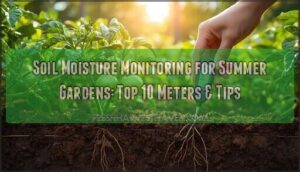



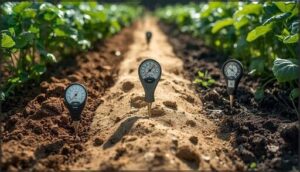
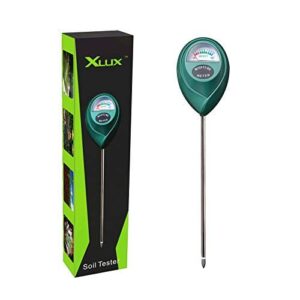

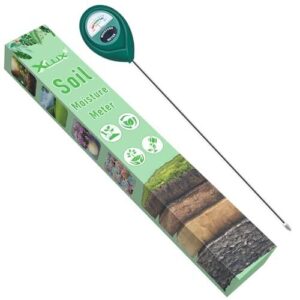

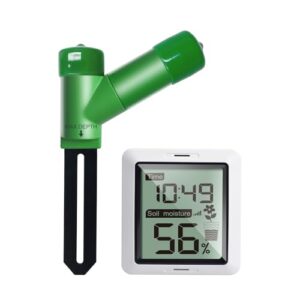

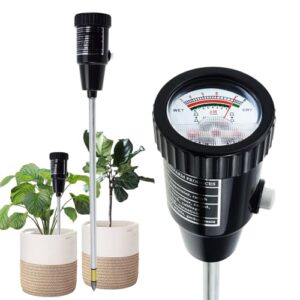
![[Upgraded] Soil Moisture Meter, 4 in 1 B0B7DQDRZC](https://freshharvesthaven.com/wp-content/uploads/2025/11/upgraded-soil-moisture-meter-4-in-1-b0b7dqdrzc-300x300.jpg)

